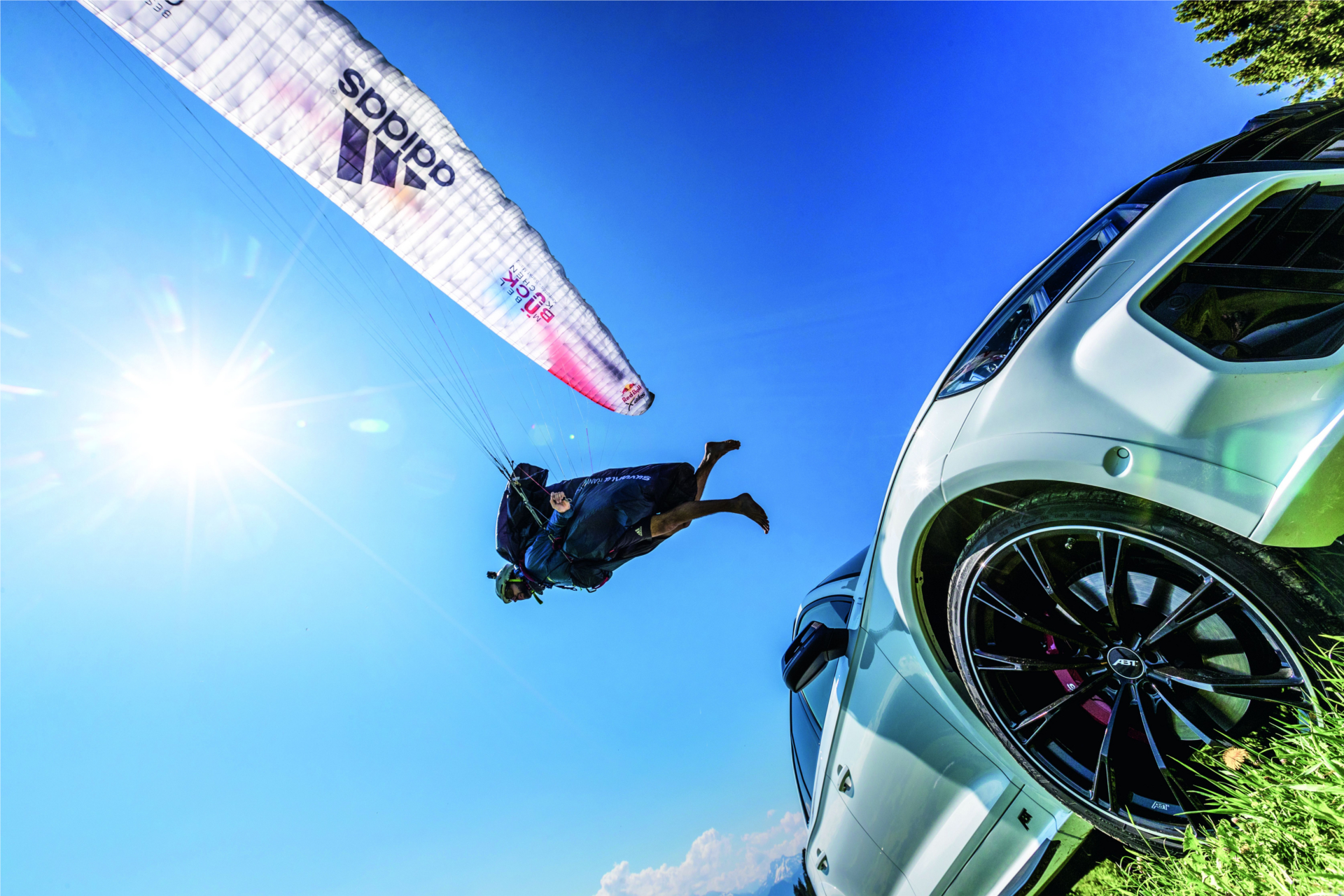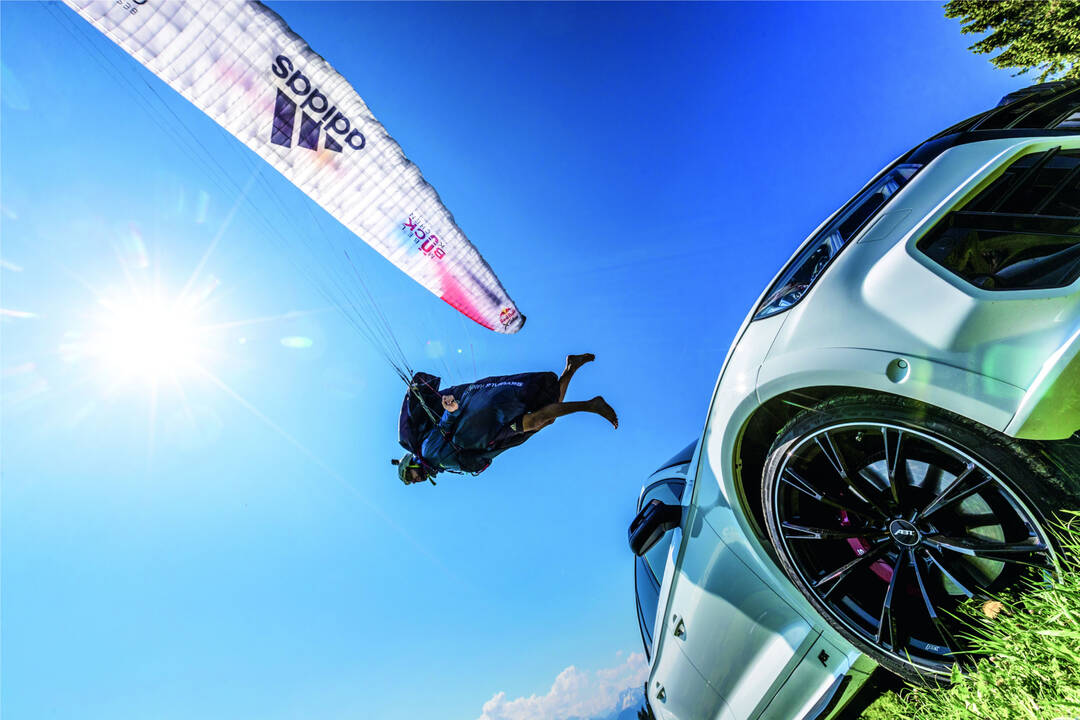High-flyer
Author | Torben Schröder
Photos | Ralf Lienert
Feeling free like a bird, just spreading your wings and discovering the world from the top view – the dream about being able to fly is something that has kept people busy for thousands of years. A pretty easy possibility to get closer to the fulfillment of this dream is offered by paragliding. “I can highly recommend that”, tandem pilot and flight instructor Tobias Böck says. “It’s the perfect mixture of a sporting activity, enjoyment of nature from a special perspective and indeed the feeling of flying.”

Up the hill with ABT POWER
We arranged an appointment in the Allgäu with Tobias Böck, his tandem colleague Manuel Nüber, photographer Ralf Lienert and Karla Kanz, press officer at ABT Sportsline. Four adults, a lot of photo technology, twice the paragliding equipment – that’s quite a lot to transport in a not that good accessible terrain. And this is where he comes into play: the ABT SQ5. With its generous storage space and a lot of climbing power, the vehicle functions as the perfect companion for the day. The photo shooting location is the Hörnerbahn, a top station at Bolsterlang, 45 kilometers southern of Kempten, the home of ABT Sportsline. The ABT SQ5 effortlessly masters the slope up to more than 1.500 altitude meters until the starting point. Shortly after arriving at the top, the white ABT with the black and silver alloy wheels and the red calipers is being checked out by other visitors of the Hörnerbahn.
The sun is out, it’s about 20 degrees warm – sounds like the perfect weather conditions to take off, right? “The conditions for paragliding mostly depend on the wind force, the wind direction and the thermal circumstances”, Tobias Böck explains. “Once these factors are optimal you can start off into a soft headwind without any problems.” Different places offer different thermal. Even the seasons matter. In spring the thermal conditions are the strongest while they tend to become weaker towards winter. “Ambitious pilots love flying in spring the most”, Böck says. “Strong up winds offer the best opportunities to complete varied and long flights. A starter could be overstrained with these circumstances. Clam flights are better during winter.” Furthermore, the flight weather is also being judged by the safety. It’s always important to prevent rain. Even during the easiest rain shower there are chances that the paraglider will change its flight characteristics. A storm is a complete no-go. Tobias Böck and others can only tell if a day is suitable for flying about one or two days in advance.
Another significant factor is the starting place. Paragliding is organized via the German Paragliding Association in Germany. The association is able to train flight instructors, is home of all lower paragliding associations, organizes championships and sets up statistics. Besides that it approves terrains. “Wildly flying” is prohibited in Germany. Official starting places have to be used for the lift off. The Hörnerbahn is such an official starting point. The Allgäu is a true paraglider’s paradise in general. But also Austria, France, Italy and Switzerland offer many possibilities for paragliders to exercise their kind of sports.

Let’s get practical
At first, preparations need to be done. The equipment essentially consists of two components besides some appropriate outdoor clothing: the harness and the flyer’s seat. This has to be buckled around the body, fixed on the chest and legs. The harness is connected to the lifting straps of the paraglide via carbines. The paraglide is the sail that carries the flyer up in the air. Paragliders are normally made of a mixture of nylon and synthetics. Depending on the quality, a completely new paragliding equipment costs at least 3000 euros, a used one at least 1500 euros.

It’s about to get sporty
The harness fits, the paraglider is spread on the floor and the wind blows in a good way. Now you just have to spot a good position and: run! “Starting spots always consist of a sloping terrain”, Tobias Böck says. “So you start by running downhill. You don’t have to run that fast if the wind is strong but you have to run faster if the wind is weak. You need to pull up the paraglider with the harness. Once you can make sure that it’s completely opened you need to accelerate again until the paraglider carries you up in the air.“ In principle, the flyer is at descent from then on. You can direct via the break-ropes and certain body placements. Practiced flyers can also gain height. Tobias Böck explains how this is possible: “You need up winds for that. At first you need to know where those are and secondly you need to know how to use them.” This technique enables flights that can last several hours and take hundreds of kilometers. But what about the risks? Is paragliding some kind of extreme sports? “Every outdoor sports is risky in some ways”, Böck tells. “But paragliding can be a very safe thing to do if you have enough respect. There also are rules in aviation you need to follow. The biggest risks are brought along by the weather and the correct assessment of your own skills.”
In Germany there also are special landing sites that have to be used best case. If you own an appropriate flight license you are also allowed to land in arbitrary places. “The landing process equals the normal aviation”, Tobias Böck says with a smile. “You always follow a certain pattern. The actual hitting of the floor is pretty innocuous. It feels like jumping off a chair.”

Gained a taste for paragliding?
Tobias Böck is the co-owner of “vogelfrei”, a company that offers paragliding tandem flights where the extraordinary experience is enabled alongside a professional, just like it is at tandem skydiving. “I used to fly together with my uncle. He went in for that sports very soon after it became a thing”, Böck explains. What started out as a hobby has developed into his profession shortly after. He also expands the business by offering tandem flights with his business-partner Michael Gebert. The concept appeals and Manuel Nübel joined the team. Some years later the company merged with the former competitor Flyzone by Rainer Scheltdorf. Böck says “a tandem flight perfectly makes sense to get in touch with that kind of sports. You don’t need any prior knowledge and no equipment.” The costs depend on the duration, the distance and the height and amount between 99 and 325 euros.
The paragliding-nerds can also take part in different competitions with different disciplines. In the discipline of acrobatic flying, the contestants perform the most spectacular maneuvers up to a roll over in front of the judges. In another field of competitive flying, it is about skillfully using the up winds in order to cover the longest possible route with the highest possible speed. Additionally, so called hike-and-fly competitions also become more and more popular. That’s a kind of competition where long routes are being covered by foot and with the paraglider which can last several days. One of the most popular hike-and-fly-events is the Red Bull X-Alps with 30 of the world’s best paragliding pilots competing every two years. Michael Gebert and Manuel Nübel both took part several times already. “Up the hill, fly as far as possible, continue the hike, hike the next mountain, fly as far as possible and so on. That truly is exhausting but it’s also great fun”, Manuel Nübel says. “But that surely is nothing for a beginner.”

ABT SQ5
Cylinder: V6 – turbo gas engine
Displacement: 2.995 ccm
Performance: 425 PS
Torque: 550 Nm
0–100 km/h: 5,2 secs.
Vmax: 250 km/h
